Stakeholder Analysis of Sainsbury: Theories, Practices, and Methodologies
VerifiedAdded on 2023/06/15
|13
|3899
|173
AI Summary
This report provides a detailed analysis of stakeholder management in Sainsbury, including a clear description of the organization and its stakeholders activities, theories and practices of stakeholders analysis, relevant research methodology and secondary data, findings, and recommendations.
Contribute Materials
Your contribution can guide someone’s learning journey. Share your
documents today.
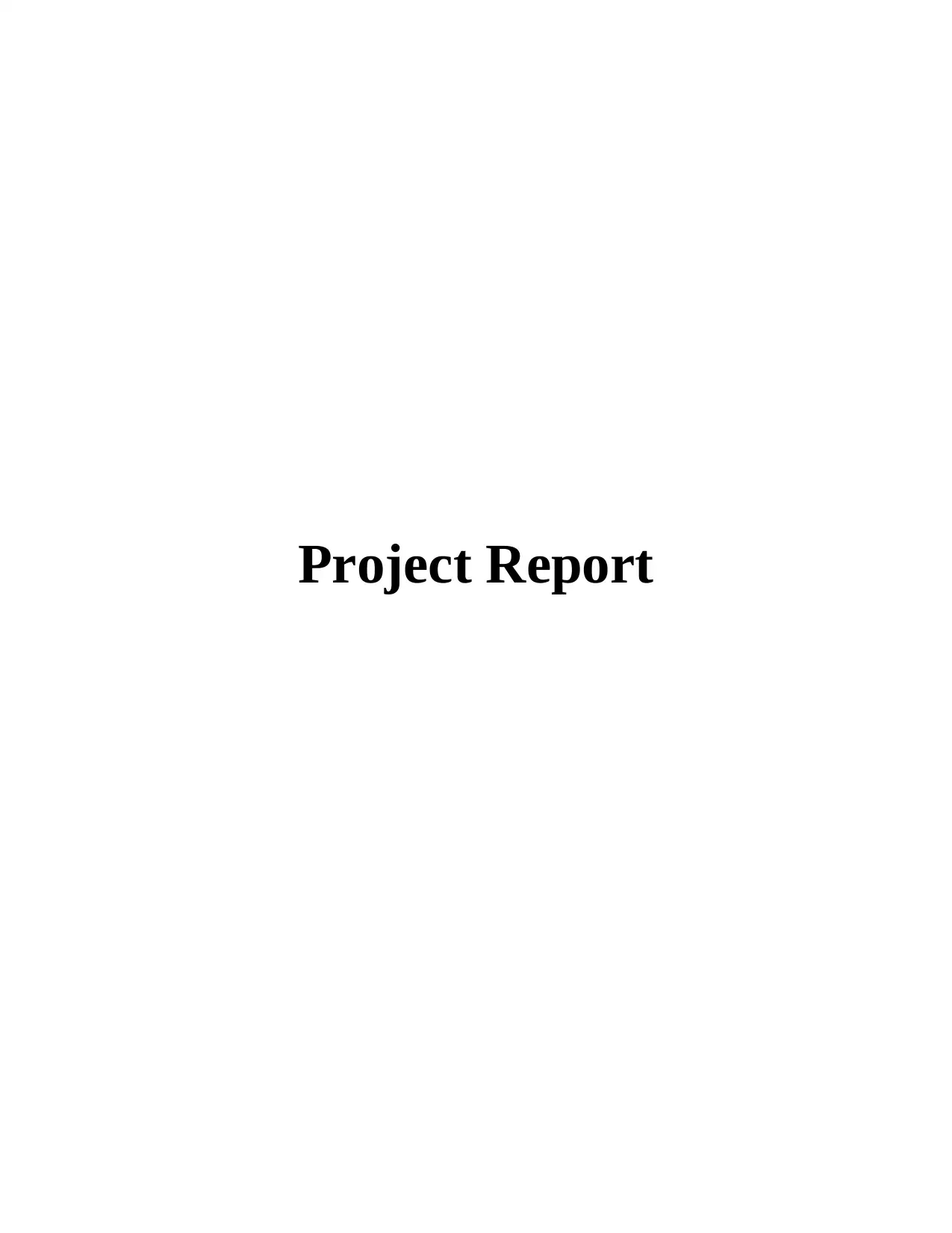
Project Report
Secure Best Marks with AI Grader
Need help grading? Try our AI Grader for instant feedback on your assignments.
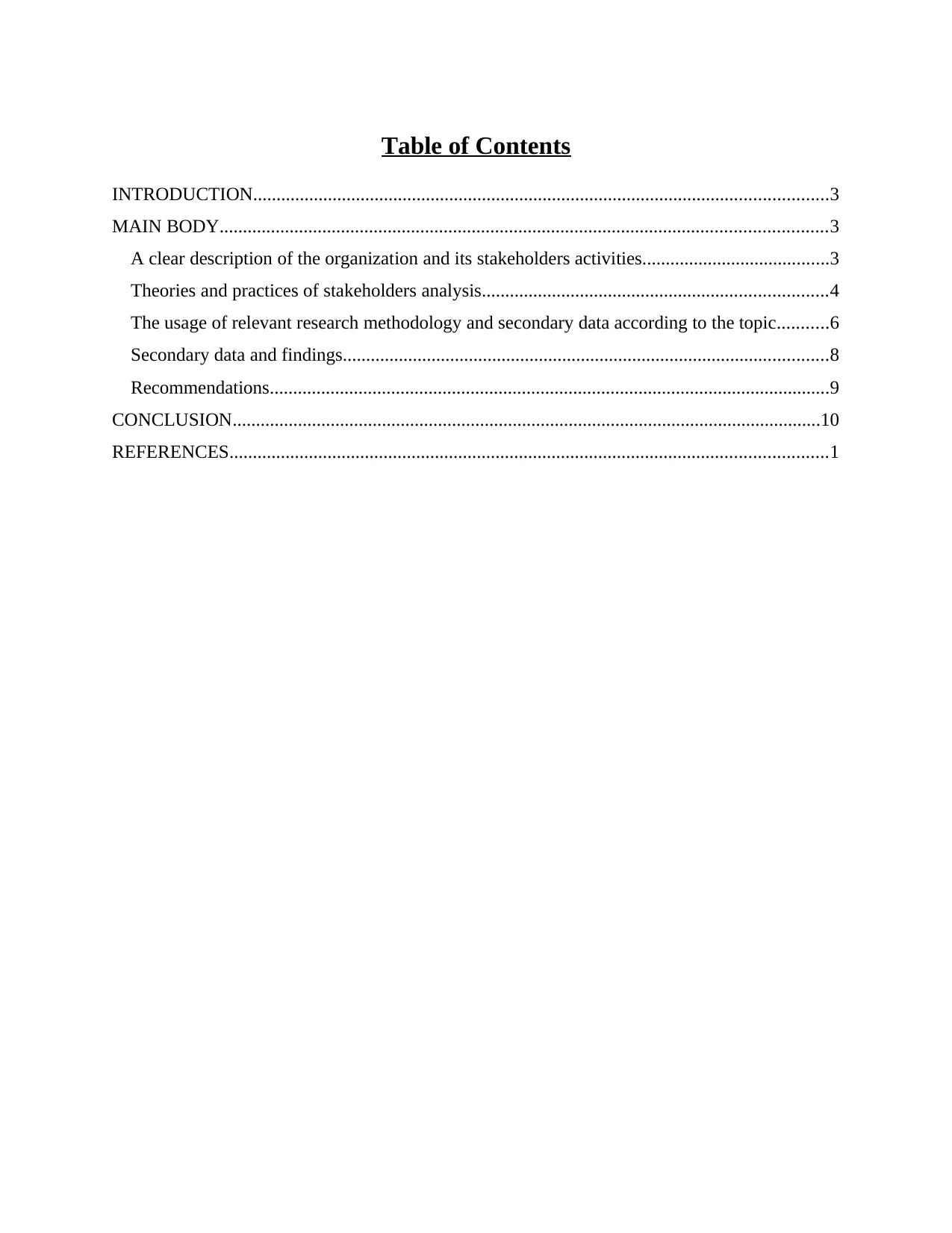
Table of Contents
INTRODUCTION...........................................................................................................................3
MAIN BODY..................................................................................................................................3
A clear description of the organization and its stakeholders activities........................................3
Theories and practices of stakeholders analysis..........................................................................4
The usage of relevant research methodology and secondary data according to the topic...........6
Secondary data and findings........................................................................................................8
Recommendations........................................................................................................................9
CONCLUSION..............................................................................................................................10
REFERENCES................................................................................................................................1
INTRODUCTION...........................................................................................................................3
MAIN BODY..................................................................................................................................3
A clear description of the organization and its stakeholders activities........................................3
Theories and practices of stakeholders analysis..........................................................................4
The usage of relevant research methodology and secondary data according to the topic...........6
Secondary data and findings........................................................................................................8
Recommendations........................................................................................................................9
CONCLUSION..............................................................................................................................10
REFERENCES................................................................................................................................1
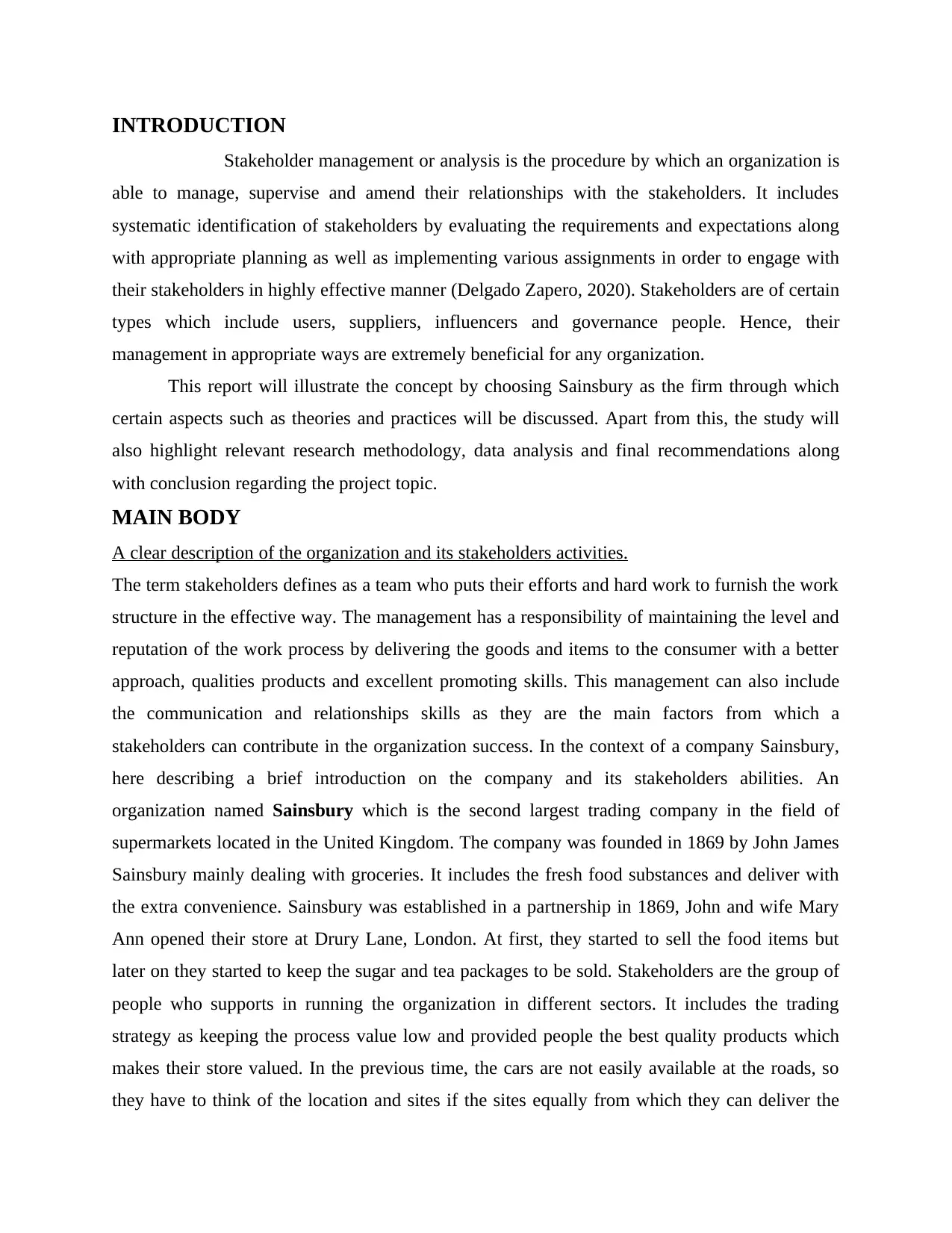
INTRODUCTION
Stakeholder management or analysis is the procedure by which an organization is
able to manage, supervise and amend their relationships with the stakeholders. It includes
systematic identification of stakeholders by evaluating the requirements and expectations along
with appropriate planning as well as implementing various assignments in order to engage with
their stakeholders in highly effective manner (Delgado Zapero, 2020). Stakeholders are of certain
types which include users, suppliers, influencers and governance people. Hence, their
management in appropriate ways are extremely beneficial for any organization.
This report will illustrate the concept by choosing Sainsbury as the firm through which
certain aspects such as theories and practices will be discussed. Apart from this, the study will
also highlight relevant research methodology, data analysis and final recommendations along
with conclusion regarding the project topic.
MAIN BODY
A clear description of the organization and its stakeholders activities.
The term stakeholders defines as a team who puts their efforts and hard work to furnish the work
structure in the effective way. The management has a responsibility of maintaining the level and
reputation of the work process by delivering the goods and items to the consumer with a better
approach, qualities products and excellent promoting skills. This management can also include
the communication and relationships skills as they are the main factors from which a
stakeholders can contribute in the organization success. In the context of a company Sainsbury,
here describing a brief introduction on the company and its stakeholders abilities. An
organization named Sainsbury which is the second largest trading company in the field of
supermarkets located in the United Kingdom. The company was founded in 1869 by John James
Sainsbury mainly dealing with groceries. It includes the fresh food substances and deliver with
the extra convenience. Sainsbury was established in a partnership in 1869, John and wife Mary
Ann opened their store at Drury Lane, London. At first, they started to sell the food items but
later on they started to keep the sugar and tea packages to be sold. Stakeholders are the group of
people who supports in running the organization in different sectors. It includes the trading
strategy as keeping the process value low and provided people the best quality products which
makes their store valued. In the previous time, the cars are not easily available at the roads, so
they have to think of the location and sites if the sites equally from which they can deliver the
Stakeholder management or analysis is the procedure by which an organization is
able to manage, supervise and amend their relationships with the stakeholders. It includes
systematic identification of stakeholders by evaluating the requirements and expectations along
with appropriate planning as well as implementing various assignments in order to engage with
their stakeholders in highly effective manner (Delgado Zapero, 2020). Stakeholders are of certain
types which include users, suppliers, influencers and governance people. Hence, their
management in appropriate ways are extremely beneficial for any organization.
This report will illustrate the concept by choosing Sainsbury as the firm through which
certain aspects such as theories and practices will be discussed. Apart from this, the study will
also highlight relevant research methodology, data analysis and final recommendations along
with conclusion regarding the project topic.
MAIN BODY
A clear description of the organization and its stakeholders activities.
The term stakeholders defines as a team who puts their efforts and hard work to furnish the work
structure in the effective way. The management has a responsibility of maintaining the level and
reputation of the work process by delivering the goods and items to the consumer with a better
approach, qualities products and excellent promoting skills. This management can also include
the communication and relationships skills as they are the main factors from which a
stakeholders can contribute in the organization success. In the context of a company Sainsbury,
here describing a brief introduction on the company and its stakeholders abilities. An
organization named Sainsbury which is the second largest trading company in the field of
supermarkets located in the United Kingdom. The company was founded in 1869 by John James
Sainsbury mainly dealing with groceries. It includes the fresh food substances and deliver with
the extra convenience. Sainsbury was established in a partnership in 1869, John and wife Mary
Ann opened their store at Drury Lane, London. At first, they started to sell the food items but
later on they started to keep the sugar and tea packages to be sold. Stakeholders are the group of
people who supports in running the organization in different sectors. It includes the trading
strategy as keeping the process value low and provided people the best quality products which
makes their store valued. In the previous time, the cars are not easily available at the roads, so
they have to think of the location and sites if the sites equally from which they can deliver the
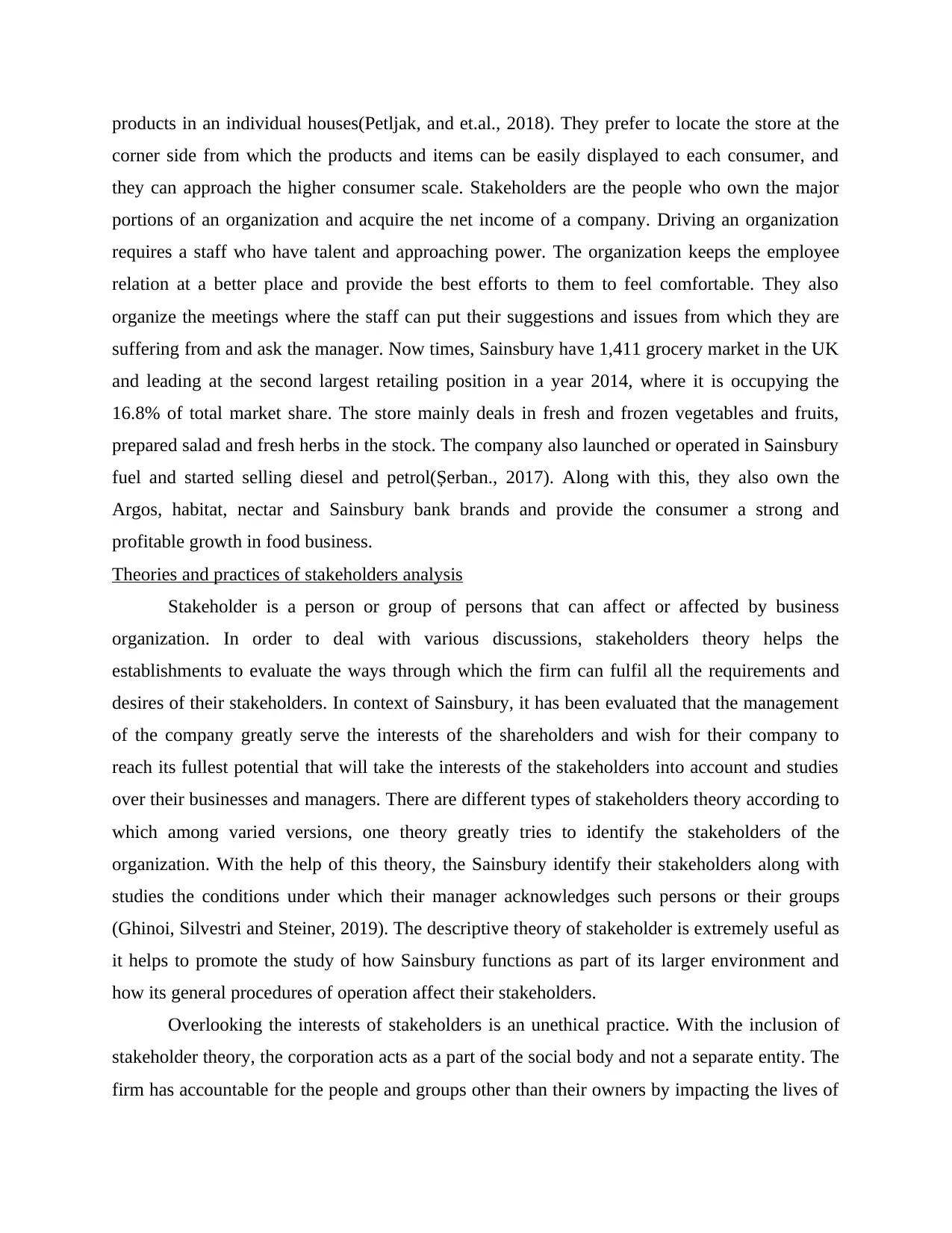
products in an individual houses(Petljak, and et.al., 2018). They prefer to locate the store at the
corner side from which the products and items can be easily displayed to each consumer, and
they can approach the higher consumer scale. Stakeholders are the people who own the major
portions of an organization and acquire the net income of a company. Driving an organization
requires a staff who have talent and approaching power. The organization keeps the employee
relation at a better place and provide the best efforts to them to feel comfortable. They also
organize the meetings where the staff can put their suggestions and issues from which they are
suffering from and ask the manager. Now times, Sainsbury have 1,411 grocery market in the UK
and leading at the second largest retailing position in a year 2014, where it is occupying the
16.8% of total market share. The store mainly deals in fresh and frozen vegetables and fruits,
prepared salad and fresh herbs in the stock. The company also launched or operated in Sainsbury
fuel and started selling diesel and petrol(Șerban., 2017). Along with this, they also own the
Argos, habitat, nectar and Sainsbury bank brands and provide the consumer a strong and
profitable growth in food business.
Theories and practices of stakeholders analysis
Stakeholder is a person or group of persons that can affect or affected by business
organization. In order to deal with various discussions, stakeholders theory helps the
establishments to evaluate the ways through which the firm can fulfil all the requirements and
desires of their stakeholders. In context of Sainsbury, it has been evaluated that the management
of the company greatly serve the interests of the shareholders and wish for their company to
reach its fullest potential that will take the interests of the stakeholders into account and studies
over their businesses and managers. There are different types of stakeholders theory according to
which among varied versions, one theory greatly tries to identify the stakeholders of the
organization. With the help of this theory, the Sainsbury identify their stakeholders along with
studies the conditions under which their manager acknowledges such persons or their groups
(Ghinoi, Silvestri and Steiner, 2019). The descriptive theory of stakeholder is extremely useful as
it helps to promote the study of how Sainsbury functions as part of its larger environment and
how its general procedures of operation affect their stakeholders.
Overlooking the interests of stakeholders is an unethical practice. With the inclusion of
stakeholder theory, the corporation acts as a part of the social body and not a separate entity. The
firm has accountable for the people and groups other than their owners by impacting the lives of
corner side from which the products and items can be easily displayed to each consumer, and
they can approach the higher consumer scale. Stakeholders are the people who own the major
portions of an organization and acquire the net income of a company. Driving an organization
requires a staff who have talent and approaching power. The organization keeps the employee
relation at a better place and provide the best efforts to them to feel comfortable. They also
organize the meetings where the staff can put their suggestions and issues from which they are
suffering from and ask the manager. Now times, Sainsbury have 1,411 grocery market in the UK
and leading at the second largest retailing position in a year 2014, where it is occupying the
16.8% of total market share. The store mainly deals in fresh and frozen vegetables and fruits,
prepared salad and fresh herbs in the stock. The company also launched or operated in Sainsbury
fuel and started selling diesel and petrol(Șerban., 2017). Along with this, they also own the
Argos, habitat, nectar and Sainsbury bank brands and provide the consumer a strong and
profitable growth in food business.
Theories and practices of stakeholders analysis
Stakeholder is a person or group of persons that can affect or affected by business
organization. In order to deal with various discussions, stakeholders theory helps the
establishments to evaluate the ways through which the firm can fulfil all the requirements and
desires of their stakeholders. In context of Sainsbury, it has been evaluated that the management
of the company greatly serve the interests of the shareholders and wish for their company to
reach its fullest potential that will take the interests of the stakeholders into account and studies
over their businesses and managers. There are different types of stakeholders theory according to
which among varied versions, one theory greatly tries to identify the stakeholders of the
organization. With the help of this theory, the Sainsbury identify their stakeholders along with
studies the conditions under which their manager acknowledges such persons or their groups
(Ghinoi, Silvestri and Steiner, 2019). The descriptive theory of stakeholder is extremely useful as
it helps to promote the study of how Sainsbury functions as part of its larger environment and
how its general procedures of operation affect their stakeholders.
Overlooking the interests of stakeholders is an unethical practice. With the inclusion of
stakeholder theory, the corporation acts as a part of the social body and not a separate entity. The
firm has accountable for the people and groups other than their owners by impacting the lives of
Secure Best Marks with AI Grader
Need help grading? Try our AI Grader for instant feedback on your assignments.

individuals such as customers and specifically their employees who are highly dependent upon
the firm. This also impacts the groups like governmental bodies which in turn impacts the
country as well as their citizens. Major corporate bodies have an importance over the economy of
multiple countries. This greatly affects the lives of people ho are not actually connected to the
firm in one or other ways. Basically it has been evaluated that there are three aspects of
stakeholders theory such as descriptive approach which explains the features and actions of
Sainsbury. This involves the whole procedure of management and the ways in which managers
manage the things. Another one is instrumental theory of approach which make use of empirical
data to identify links among the management of stakeholder groups along with the attainment of
corporate goals. It is very normative kind of approach which establishes ethical guidelines for the
functioning of the Sainsbury (Zedan and Miller, 2017). In order to discuss the practices taken by
Sainsbury for effectively manage their stakeholders include the evaluation of stakeholders
matrix. It is very effective tool for analysing the stakeholders. This has been analysed against
certain criteria and plotted over the graph as it helps to take detailed decision based upon the
quadrant in which any specific stakeholder falls into.
Stakeholder involves any individual or group of people with an interest in the firm. Some
stakeholders will be internal to any establishment and others will be external. It is a kind of
Stakeholders Matrix
the firm. This also impacts the groups like governmental bodies which in turn impacts the
country as well as their citizens. Major corporate bodies have an importance over the economy of
multiple countries. This greatly affects the lives of people ho are not actually connected to the
firm in one or other ways. Basically it has been evaluated that there are three aspects of
stakeholders theory such as descriptive approach which explains the features and actions of
Sainsbury. This involves the whole procedure of management and the ways in which managers
manage the things. Another one is instrumental theory of approach which make use of empirical
data to identify links among the management of stakeholder groups along with the attainment of
corporate goals. It is very normative kind of approach which establishes ethical guidelines for the
functioning of the Sainsbury (Zedan and Miller, 2017). In order to discuss the practices taken by
Sainsbury for effectively manage their stakeholders include the evaluation of stakeholders
matrix. It is very effective tool for analysing the stakeholders. This has been analysed against
certain criteria and plotted over the graph as it helps to take detailed decision based upon the
quadrant in which any specific stakeholder falls into.
Stakeholder involves any individual or group of people with an interest in the firm. Some
stakeholders will be internal to any establishment and others will be external. It is a kind of
Stakeholders Matrix
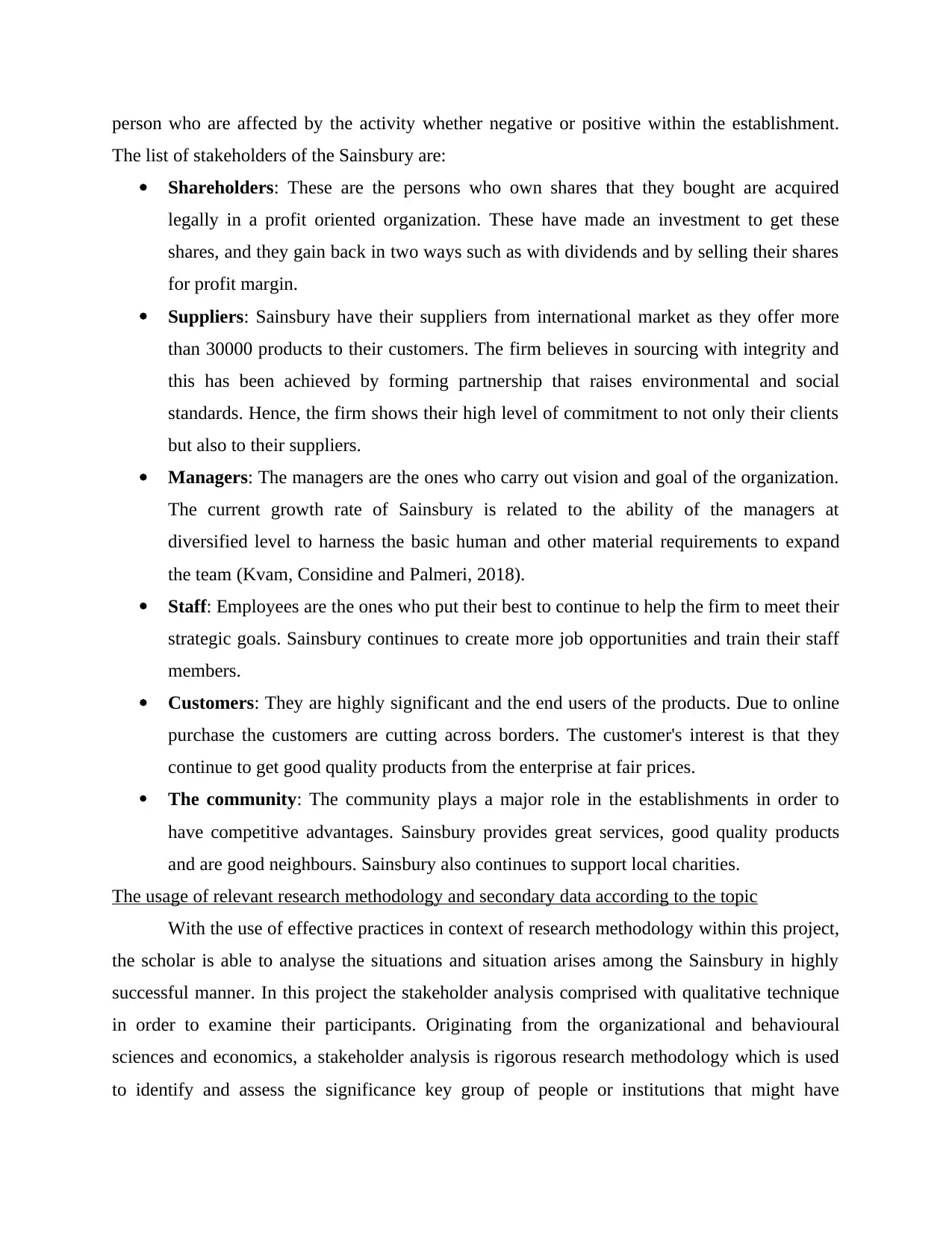
person who are affected by the activity whether negative or positive within the establishment.
The list of stakeholders of the Sainsbury are:
Shareholders: These are the persons who own shares that they bought are acquired
legally in a profit oriented organization. These have made an investment to get these
shares, and they gain back in two ways such as with dividends and by selling their shares
for profit margin.
Suppliers: Sainsbury have their suppliers from international market as they offer more
than 30000 products to their customers. The firm believes in sourcing with integrity and
this has been achieved by forming partnership that raises environmental and social
standards. Hence, the firm shows their high level of commitment to not only their clients
but also to their suppliers.
Managers: The managers are the ones who carry out vision and goal of the organization.
The current growth rate of Sainsbury is related to the ability of the managers at
diversified level to harness the basic human and other material requirements to expand
the team (Kvam, Considine and Palmeri, 2018).
Staff: Employees are the ones who put their best to continue to help the firm to meet their
strategic goals. Sainsbury continues to create more job opportunities and train their staff
members.
Customers: They are highly significant and the end users of the products. Due to online
purchase the customers are cutting across borders. The customer's interest is that they
continue to get good quality products from the enterprise at fair prices.
The community: The community plays a major role in the establishments in order to
have competitive advantages. Sainsbury provides great services, good quality products
and are good neighbours. Sainsbury also continues to support local charities.
The usage of relevant research methodology and secondary data according to the topic
With the use of effective practices in context of research methodology within this project,
the scholar is able to analyse the situations and situation arises among the Sainsbury in highly
successful manner. In this project the stakeholder analysis comprised with qualitative technique
in order to examine their participants. Originating from the organizational and behavioural
sciences and economics, a stakeholder analysis is rigorous research methodology which is used
to identify and assess the significance key group of people or institutions that might have
The list of stakeholders of the Sainsbury are:
Shareholders: These are the persons who own shares that they bought are acquired
legally in a profit oriented organization. These have made an investment to get these
shares, and they gain back in two ways such as with dividends and by selling their shares
for profit margin.
Suppliers: Sainsbury have their suppliers from international market as they offer more
than 30000 products to their customers. The firm believes in sourcing with integrity and
this has been achieved by forming partnership that raises environmental and social
standards. Hence, the firm shows their high level of commitment to not only their clients
but also to their suppliers.
Managers: The managers are the ones who carry out vision and goal of the organization.
The current growth rate of Sainsbury is related to the ability of the managers at
diversified level to harness the basic human and other material requirements to expand
the team (Kvam, Considine and Palmeri, 2018).
Staff: Employees are the ones who put their best to continue to help the firm to meet their
strategic goals. Sainsbury continues to create more job opportunities and train their staff
members.
Customers: They are highly significant and the end users of the products. Due to online
purchase the customers are cutting across borders. The customer's interest is that they
continue to get good quality products from the enterprise at fair prices.
The community: The community plays a major role in the establishments in order to
have competitive advantages. Sainsbury provides great services, good quality products
and are good neighbours. Sainsbury also continues to support local charities.
The usage of relevant research methodology and secondary data according to the topic
With the use of effective practices in context of research methodology within this project,
the scholar is able to analyse the situations and situation arises among the Sainsbury in highly
successful manner. In this project the stakeholder analysis comprised with qualitative technique
in order to examine their participants. Originating from the organizational and behavioural
sciences and economics, a stakeholder analysis is rigorous research methodology which is used
to identify and assess the significance key group of people or institutions that might have

significant influence over the success of research project (Karolemeas and et.al., 2021). As an
emergent research methodology, stakeholders analysis examines participants positions and their
influence in a group they belong, as well as the possibility of other groups influencing them. It
helps in order to identify or determine particular groups or individuals interests in the outcomes
of a given research. Furthermore, the stakeholders' matrix have been utilized as a tool for
engaging varied groups to build relationship with each other.
The procedure of data collection in the stakeholders' methodology is undertaken in
various steps such as the primary step is to develop the research issue or problems which is
followed by identification of potential people, organizations and groups with vested interests in
the research outcome. The next step is to gain clear understanding about the roles and
responsibilities and contribute into different stakeholders along with the Sainsbury institutional
affiliation. This phase is specifically necessary to make sure the balance representation of the
stakeholders. It is also intended to clearly distinguish between those who would be directly
affected by the project outcomes from those who are likely to influence the results of the
research. In order to complete this project, the verifiable secondary data was utilized as it is
readily available to the author and considered as less costly than quantitative approach. It is
basically collection of data into non-numerical format with the help of observations, interviews
and previous studies (Li, Quan and Wang, 2020). In order to complete this research, inductive
research method is applied because it allows flexibility to the scholar in order to assist the
generations of new and advanced theories. Apart from this, in order to evaluate the study in
highly efficient manner, interpretivism research philosophy method has been used into this
project because the final outcome occurs at the end of the study does not rely on over numerical
data which helps the researcher to prove research challenges regarding the evaluation of
stakeholders analysis of Sainsbury.
In context of research design, descriptive research designing method has been adopted to
give proper and detailed knowledge about the topic along with the cause and effects of studying
this specific topic (Suhaib, 2019). For further studies, which are related to the stakeholders'
analysis of the Sainsbury, the data will be collected through the medium of secondary data
collection method by utilizing viewpoints of different authors and scholars. In order to analyse
qualitative data effectively, thematic perception test technique has been used. The secondary data
analysis or collection helps to make or evaluate certain gaps along with deficiencies along with
emergent research methodology, stakeholders analysis examines participants positions and their
influence in a group they belong, as well as the possibility of other groups influencing them. It
helps in order to identify or determine particular groups or individuals interests in the outcomes
of a given research. Furthermore, the stakeholders' matrix have been utilized as a tool for
engaging varied groups to build relationship with each other.
The procedure of data collection in the stakeholders' methodology is undertaken in
various steps such as the primary step is to develop the research issue or problems which is
followed by identification of potential people, organizations and groups with vested interests in
the research outcome. The next step is to gain clear understanding about the roles and
responsibilities and contribute into different stakeholders along with the Sainsbury institutional
affiliation. This phase is specifically necessary to make sure the balance representation of the
stakeholders. It is also intended to clearly distinguish between those who would be directly
affected by the project outcomes from those who are likely to influence the results of the
research. In order to complete this project, the verifiable secondary data was utilized as it is
readily available to the author and considered as less costly than quantitative approach. It is
basically collection of data into non-numerical format with the help of observations, interviews
and previous studies (Li, Quan and Wang, 2020). In order to complete this research, inductive
research method is applied because it allows flexibility to the scholar in order to assist the
generations of new and advanced theories. Apart from this, in order to evaluate the study in
highly efficient manner, interpretivism research philosophy method has been used into this
project because the final outcome occurs at the end of the study does not rely on over numerical
data which helps the researcher to prove research challenges regarding the evaluation of
stakeholders analysis of Sainsbury.
In context of research design, descriptive research designing method has been adopted to
give proper and detailed knowledge about the topic along with the cause and effects of studying
this specific topic (Suhaib, 2019). For further studies, which are related to the stakeholders'
analysis of the Sainsbury, the data will be collected through the medium of secondary data
collection method by utilizing viewpoints of different authors and scholars. In order to analyse
qualitative data effectively, thematic perception test technique has been used. The secondary data
analysis or collection helps to make or evaluate certain gaps along with deficiencies along with
Paraphrase This Document
Need a fresh take? Get an instant paraphrase of this document with our AI Paraphraser
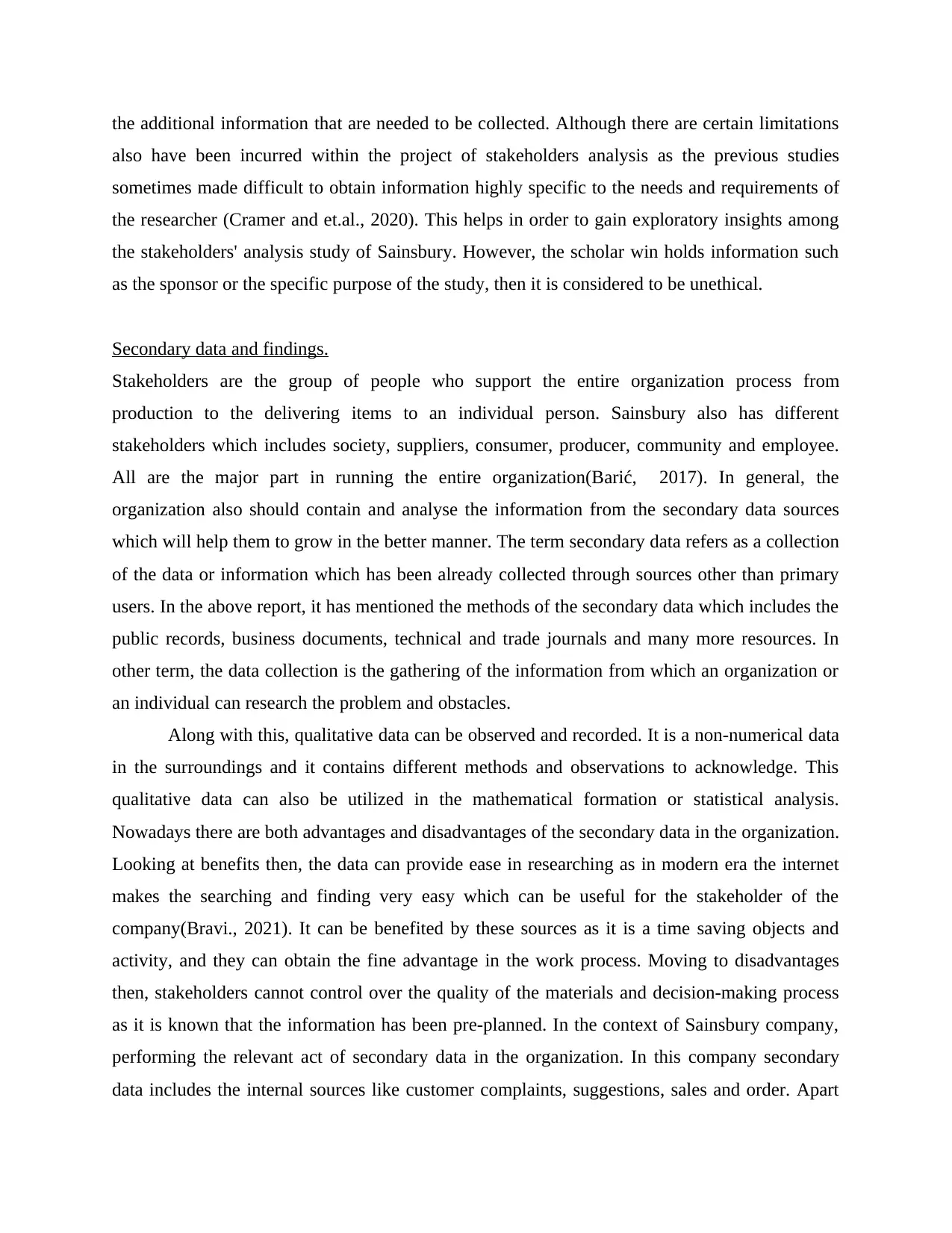
the additional information that are needed to be collected. Although there are certain limitations
also have been incurred within the project of stakeholders analysis as the previous studies
sometimes made difficult to obtain information highly specific to the needs and requirements of
the researcher (Cramer and et.al., 2020). This helps in order to gain exploratory insights among
the stakeholders' analysis study of Sainsbury. However, the scholar win holds information such
as the sponsor or the specific purpose of the study, then it is considered to be unethical.
Secondary data and findings.
Stakeholders are the group of people who support the entire organization process from
production to the delivering items to an individual person. Sainsbury also has different
stakeholders which includes society, suppliers, consumer, producer, community and employee.
All are the major part in running the entire organization(Barić, 2017). In general, the
organization also should contain and analyse the information from the secondary data sources
which will help them to grow in the better manner. The term secondary data refers as a collection
of the data or information which has been already collected through sources other than primary
users. In the above report, it has mentioned the methods of the secondary data which includes the
public records, business documents, technical and trade journals and many more resources. In
other term, the data collection is the gathering of the information from which an organization or
an individual can research the problem and obstacles.
Along with this, qualitative data can be observed and recorded. It is a non-numerical data
in the surroundings and it contains different methods and observations to acknowledge. This
qualitative data can also be utilized in the mathematical formation or statistical analysis.
Nowadays there are both advantages and disadvantages of the secondary data in the organization.
Looking at benefits then, the data can provide ease in researching as in modern era the internet
makes the searching and finding very easy which can be useful for the stakeholder of the
company(Bravi., 2021). It can be benefited by these sources as it is a time saving objects and
activity, and they can obtain the fine advantage in the work process. Moving to disadvantages
then, stakeholders cannot control over the quality of the materials and decision-making process
as it is known that the information has been pre-planned. In the context of Sainsbury company,
performing the relevant act of secondary data in the organization. In this company secondary
data includes the internal sources like customer complaints, suggestions, sales and order. Apart
also have been incurred within the project of stakeholders analysis as the previous studies
sometimes made difficult to obtain information highly specific to the needs and requirements of
the researcher (Cramer and et.al., 2020). This helps in order to gain exploratory insights among
the stakeholders' analysis study of Sainsbury. However, the scholar win holds information such
as the sponsor or the specific purpose of the study, then it is considered to be unethical.
Secondary data and findings.
Stakeholders are the group of people who support the entire organization process from
production to the delivering items to an individual person. Sainsbury also has different
stakeholders which includes society, suppliers, consumer, producer, community and employee.
All are the major part in running the entire organization(Barić, 2017). In general, the
organization also should contain and analyse the information from the secondary data sources
which will help them to grow in the better manner. The term secondary data refers as a collection
of the data or information which has been already collected through sources other than primary
users. In the above report, it has mentioned the methods of the secondary data which includes the
public records, business documents, technical and trade journals and many more resources. In
other term, the data collection is the gathering of the information from which an organization or
an individual can research the problem and obstacles.
Along with this, qualitative data can be observed and recorded. It is a non-numerical data
in the surroundings and it contains different methods and observations to acknowledge. This
qualitative data can also be utilized in the mathematical formation or statistical analysis.
Nowadays there are both advantages and disadvantages of the secondary data in the organization.
Looking at benefits then, the data can provide ease in researching as in modern era the internet
makes the searching and finding very easy which can be useful for the stakeholder of the
company(Bravi., 2021). It can be benefited by these sources as it is a time saving objects and
activity, and they can obtain the fine advantage in the work process. Moving to disadvantages
then, stakeholders cannot control over the quality of the materials and decision-making process
as it is known that the information has been pre-planned. In the context of Sainsbury company,
performing the relevant act of secondary data in the organization. In this company secondary
data includes the internal sources like customer complaints, suggestions, sales and order. Apart
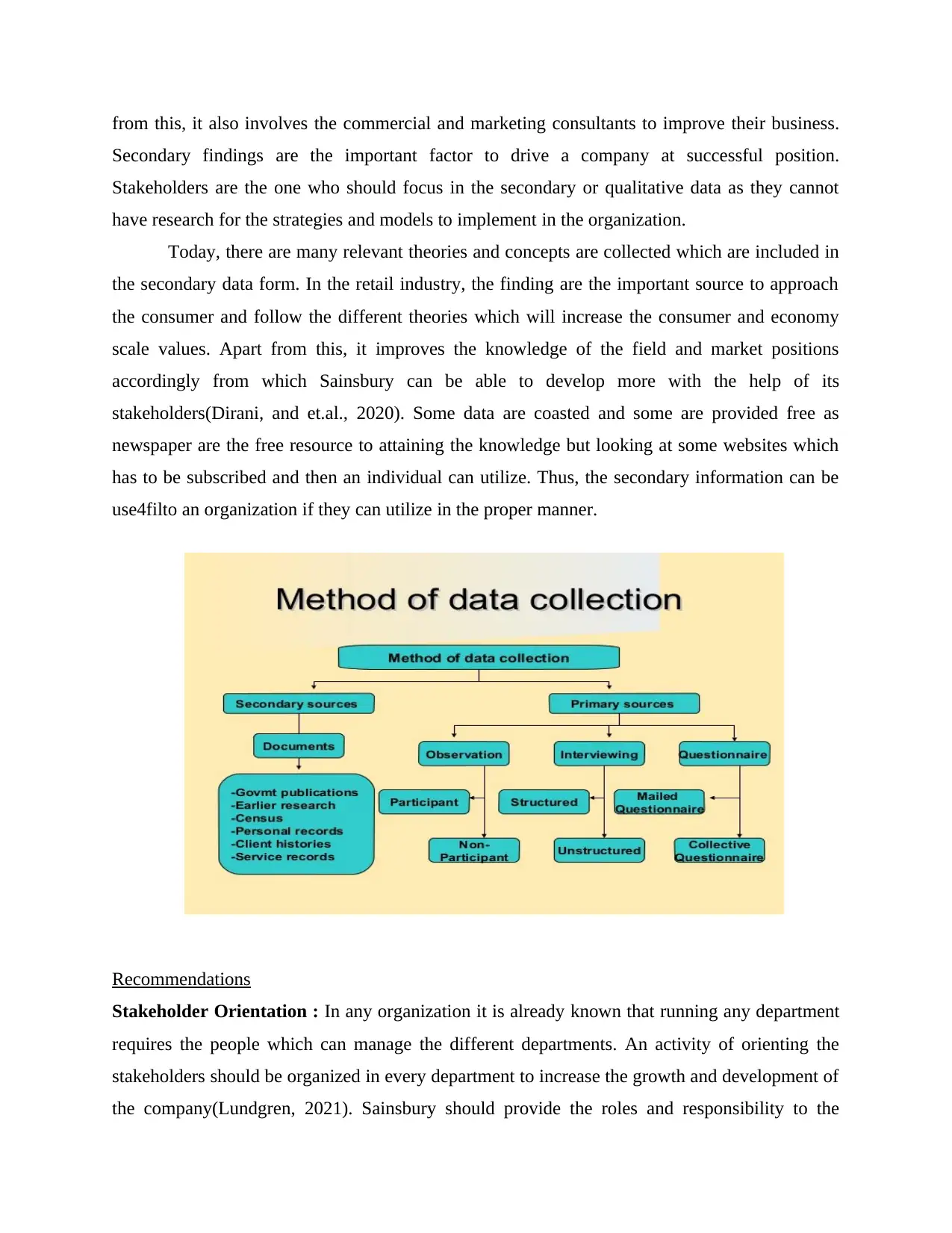
from this, it also involves the commercial and marketing consultants to improve their business.
Secondary findings are the important factor to drive a company at successful position.
Stakeholders are the one who should focus in the secondary or qualitative data as they cannot
have research for the strategies and models to implement in the organization.
Today, there are many relevant theories and concepts are collected which are included in
the secondary data form. In the retail industry, the finding are the important source to approach
the consumer and follow the different theories which will increase the consumer and economy
scale values. Apart from this, it improves the knowledge of the field and market positions
accordingly from which Sainsbury can be able to develop more with the help of its
stakeholders(Dirani, and et.al., 2020). Some data are coasted and some are provided free as
newspaper are the free resource to attaining the knowledge but looking at some websites which
has to be subscribed and then an individual can utilize. Thus, the secondary information can be
use4filto an organization if they can utilize in the proper manner.
Recommendations
Stakeholder Orientation : In any organization it is already known that running any department
requires the people which can manage the different departments. An activity of orienting the
stakeholders should be organized in every department to increase the growth and development of
the company(Lundgren, 2021). Sainsbury should provide the roles and responsibility to the
Secondary findings are the important factor to drive a company at successful position.
Stakeholders are the one who should focus in the secondary or qualitative data as they cannot
have research for the strategies and models to implement in the organization.
Today, there are many relevant theories and concepts are collected which are included in
the secondary data form. In the retail industry, the finding are the important source to approach
the consumer and follow the different theories which will increase the consumer and economy
scale values. Apart from this, it improves the knowledge of the field and market positions
accordingly from which Sainsbury can be able to develop more with the help of its
stakeholders(Dirani, and et.al., 2020). Some data are coasted and some are provided free as
newspaper are the free resource to attaining the knowledge but looking at some websites which
has to be subscribed and then an individual can utilize. Thus, the secondary information can be
use4filto an organization if they can utilize in the proper manner.
Recommendations
Stakeholder Orientation : In any organization it is already known that running any department
requires the people which can manage the different departments. An activity of orienting the
stakeholders should be organized in every department to increase the growth and development of
the company(Lundgren, 2021). Sainsbury should provide the roles and responsibility to the
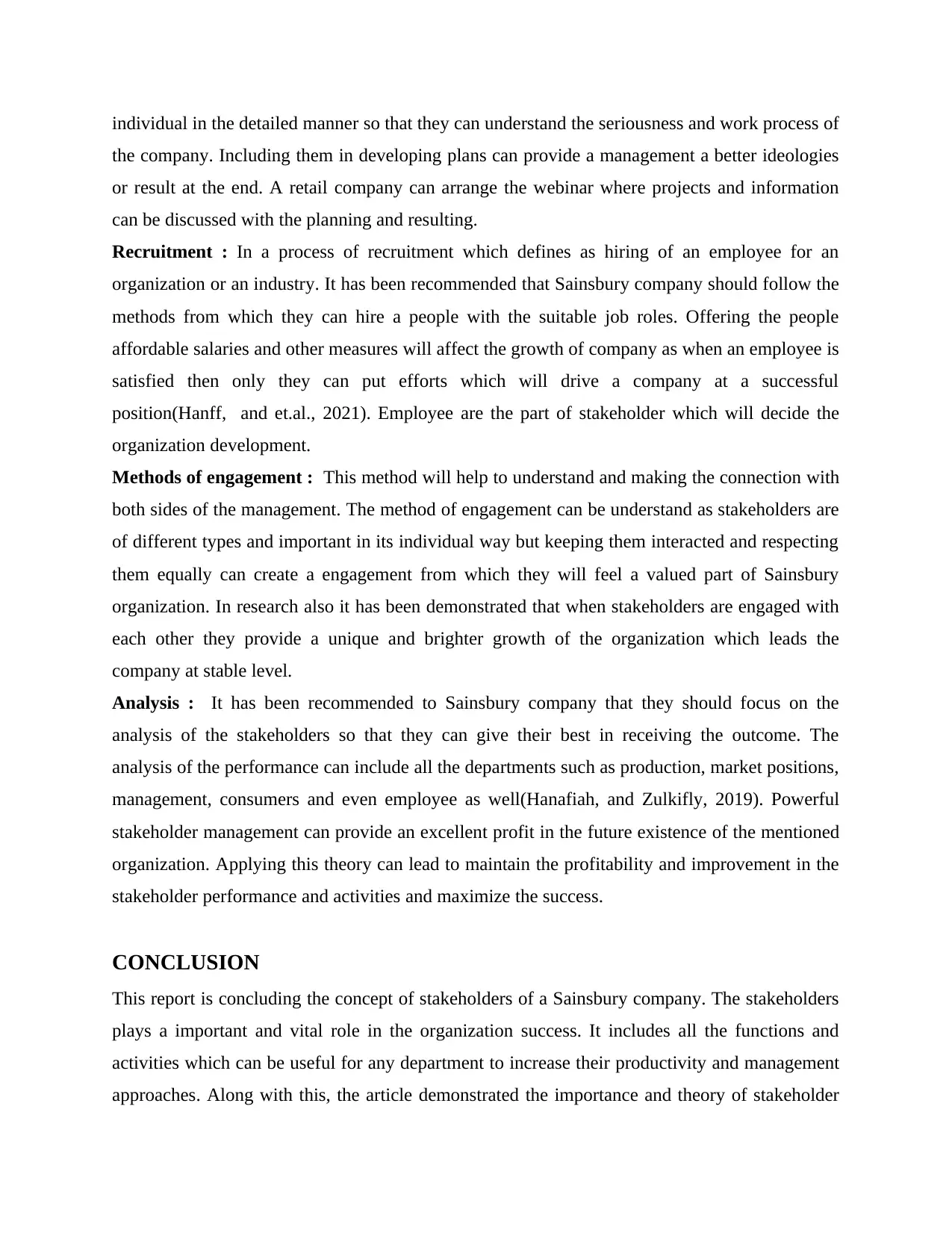
individual in the detailed manner so that they can understand the seriousness and work process of
the company. Including them in developing plans can provide a management a better ideologies
or result at the end. A retail company can arrange the webinar where projects and information
can be discussed with the planning and resulting.
Recruitment : In a process of recruitment which defines as hiring of an employee for an
organization or an industry. It has been recommended that Sainsbury company should follow the
methods from which they can hire a people with the suitable job roles. Offering the people
affordable salaries and other measures will affect the growth of company as when an employee is
satisfied then only they can put efforts which will drive a company at a successful
position(Hanff, and et.al., 2021). Employee are the part of stakeholder which will decide the
organization development.
Methods of engagement : This method will help to understand and making the connection with
both sides of the management. The method of engagement can be understand as stakeholders are
of different types and important in its individual way but keeping them interacted and respecting
them equally can create a engagement from which they will feel a valued part of Sainsbury
organization. In research also it has been demonstrated that when stakeholders are engaged with
each other they provide a unique and brighter growth of the organization which leads the
company at stable level.
Analysis : It has been recommended to Sainsbury company that they should focus on the
analysis of the stakeholders so that they can give their best in receiving the outcome. The
analysis of the performance can include all the departments such as production, market positions,
management, consumers and even employee as well(Hanafiah, and Zulkifly, 2019). Powerful
stakeholder management can provide an excellent profit in the future existence of the mentioned
organization. Applying this theory can lead to maintain the profitability and improvement in the
stakeholder performance and activities and maximize the success.
CONCLUSION
This report is concluding the concept of stakeholders of a Sainsbury company. The stakeholders
plays a important and vital role in the organization success. It includes all the functions and
activities which can be useful for any department to increase their productivity and management
approaches. Along with this, the article demonstrated the importance and theory of stakeholder
the company. Including them in developing plans can provide a management a better ideologies
or result at the end. A retail company can arrange the webinar where projects and information
can be discussed with the planning and resulting.
Recruitment : In a process of recruitment which defines as hiring of an employee for an
organization or an industry. It has been recommended that Sainsbury company should follow the
methods from which they can hire a people with the suitable job roles. Offering the people
affordable salaries and other measures will affect the growth of company as when an employee is
satisfied then only they can put efforts which will drive a company at a successful
position(Hanff, and et.al., 2021). Employee are the part of stakeholder which will decide the
organization development.
Methods of engagement : This method will help to understand and making the connection with
both sides of the management. The method of engagement can be understand as stakeholders are
of different types and important in its individual way but keeping them interacted and respecting
them equally can create a engagement from which they will feel a valued part of Sainsbury
organization. In research also it has been demonstrated that when stakeholders are engaged with
each other they provide a unique and brighter growth of the organization which leads the
company at stable level.
Analysis : It has been recommended to Sainsbury company that they should focus on the
analysis of the stakeholders so that they can give their best in receiving the outcome. The
analysis of the performance can include all the departments such as production, market positions,
management, consumers and even employee as well(Hanafiah, and Zulkifly, 2019). Powerful
stakeholder management can provide an excellent profit in the future existence of the mentioned
organization. Applying this theory can lead to maintain the profitability and improvement in the
stakeholder performance and activities and maximize the success.
CONCLUSION
This report is concluding the concept of stakeholders of a Sainsbury company. The stakeholders
plays a important and vital role in the organization success. It includes all the functions and
activities which can be useful for any department to increase their productivity and management
approaches. Along with this, the article demonstrated the importance and theory of stakeholder
Secure Best Marks with AI Grader
Need help grading? Try our AI Grader for instant feedback on your assignments.
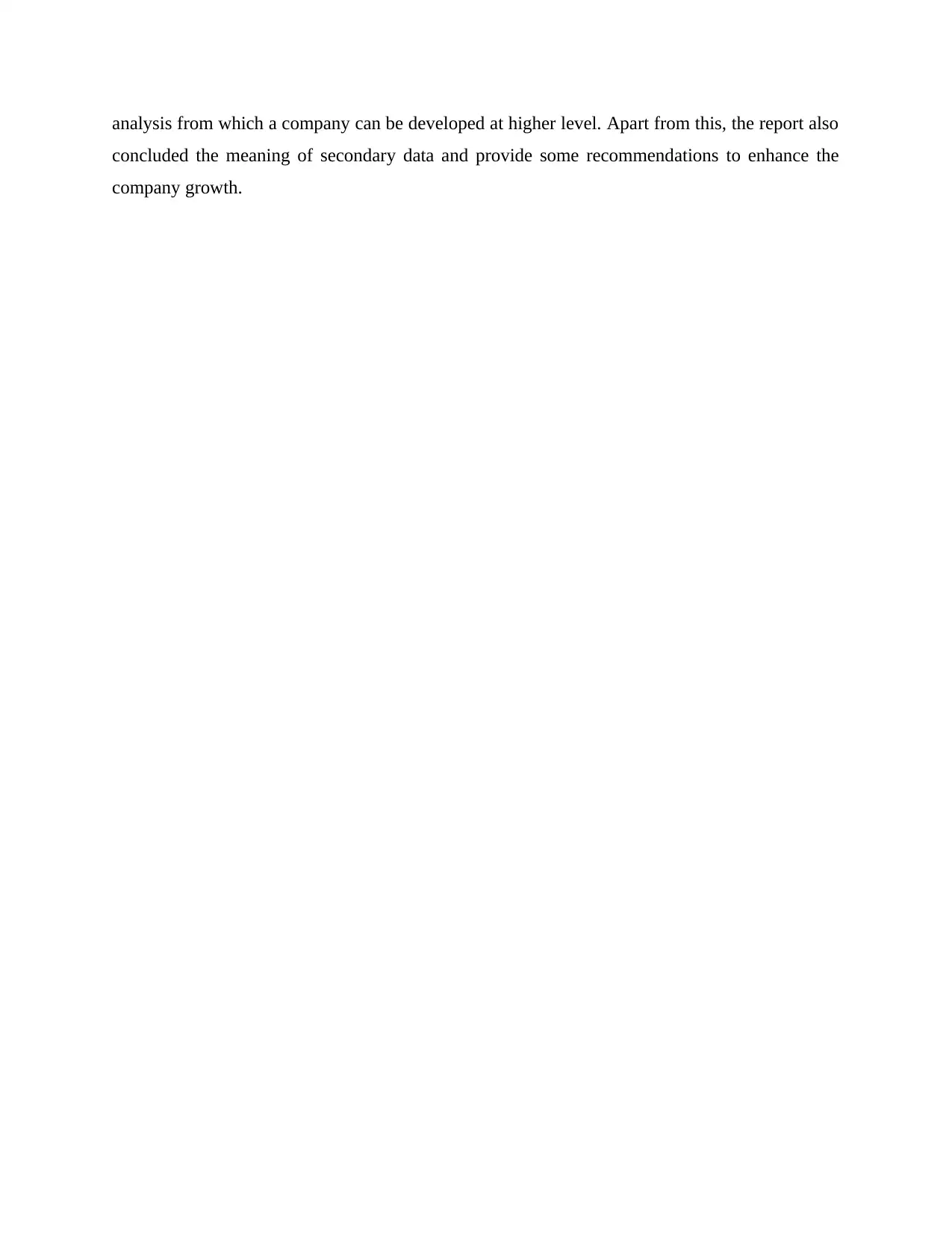
analysis from which a company can be developed at higher level. Apart from this, the report also
concluded the meaning of secondary data and provide some recommendations to enhance the
company growth.
concluded the meaning of secondary data and provide some recommendations to enhance the
company growth.
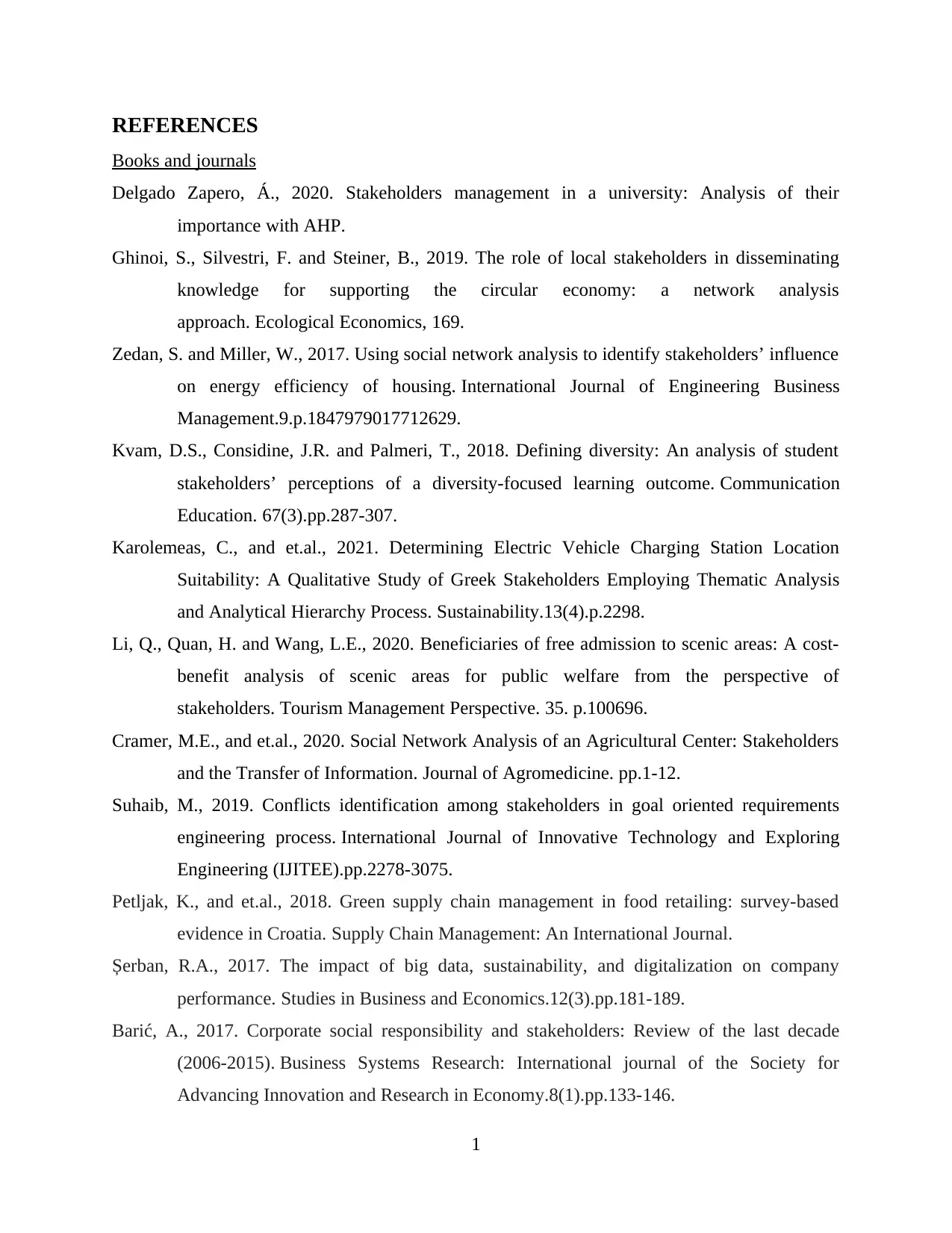
REFERENCES
Books and journals
Delgado Zapero, Á., 2020. Stakeholders management in a university: Analysis of their
importance with AHP.
Ghinoi, S., Silvestri, F. and Steiner, B., 2019. The role of local stakeholders in disseminating
knowledge for supporting the circular economy: a network analysis
approach. Ecological Economics, 169.
Zedan, S. and Miller, W., 2017. Using social network analysis to identify stakeholders’ influence
on energy efficiency of housing. International Journal of Engineering Business
Management.9.p.1847979017712629.
Kvam, D.S., Considine, J.R. and Palmeri, T., 2018. Defining diversity: An analysis of student
stakeholders’ perceptions of a diversity-focused learning outcome. Communication
Education. 67(3).pp.287-307.
Karolemeas, C., and et.al., 2021. Determining Electric Vehicle Charging Station Location
Suitability: A Qualitative Study of Greek Stakeholders Employing Thematic Analysis
and Analytical Hierarchy Process. Sustainability.13(4).p.2298.
Li, Q., Quan, H. and Wang, L.E., 2020. Beneficiaries of free admission to scenic areas: A cost-
benefit analysis of scenic areas for public welfare from the perspective of
stakeholders. Tourism Management Perspective. 35. p.100696.
Cramer, M.E., and et.al., 2020. Social Network Analysis of an Agricultural Center: Stakeholders
and the Transfer of Information. Journal of Agromedicine. pp.1-12.
Suhaib, M., 2019. Conflicts identification among stakeholders in goal oriented requirements
engineering process. International Journal of Innovative Technology and Exploring
Engineering (IJITEE).pp.2278-3075.
Petljak, K., and et.al., 2018. Green supply chain management in food retailing: survey-based
evidence in Croatia. Supply Chain Management: An International Journal.
Șerban, R.A., 2017. The impact of big data, sustainability, and digitalization on company
performance. Studies in Business and Economics.12(3).pp.181-189.
Barić, A., 2017. Corporate social responsibility and stakeholders: Review of the last decade
(2006-2015). Business Systems Research: International journal of the Society for
Advancing Innovation and Research in Economy.8(1).pp.133-146.
1
Books and journals
Delgado Zapero, Á., 2020. Stakeholders management in a university: Analysis of their
importance with AHP.
Ghinoi, S., Silvestri, F. and Steiner, B., 2019. The role of local stakeholders in disseminating
knowledge for supporting the circular economy: a network analysis
approach. Ecological Economics, 169.
Zedan, S. and Miller, W., 2017. Using social network analysis to identify stakeholders’ influence
on energy efficiency of housing. International Journal of Engineering Business
Management.9.p.1847979017712629.
Kvam, D.S., Considine, J.R. and Palmeri, T., 2018. Defining diversity: An analysis of student
stakeholders’ perceptions of a diversity-focused learning outcome. Communication
Education. 67(3).pp.287-307.
Karolemeas, C., and et.al., 2021. Determining Electric Vehicle Charging Station Location
Suitability: A Qualitative Study of Greek Stakeholders Employing Thematic Analysis
and Analytical Hierarchy Process. Sustainability.13(4).p.2298.
Li, Q., Quan, H. and Wang, L.E., 2020. Beneficiaries of free admission to scenic areas: A cost-
benefit analysis of scenic areas for public welfare from the perspective of
stakeholders. Tourism Management Perspective. 35. p.100696.
Cramer, M.E., and et.al., 2020. Social Network Analysis of an Agricultural Center: Stakeholders
and the Transfer of Information. Journal of Agromedicine. pp.1-12.
Suhaib, M., 2019. Conflicts identification among stakeholders in goal oriented requirements
engineering process. International Journal of Innovative Technology and Exploring
Engineering (IJITEE).pp.2278-3075.
Petljak, K., and et.al., 2018. Green supply chain management in food retailing: survey-based
evidence in Croatia. Supply Chain Management: An International Journal.
Șerban, R.A., 2017. The impact of big data, sustainability, and digitalization on company
performance. Studies in Business and Economics.12(3).pp.181-189.
Barić, A., 2017. Corporate social responsibility and stakeholders: Review of the last decade
(2006-2015). Business Systems Research: International journal of the Society for
Advancing Innovation and Research in Economy.8(1).pp.133-146.
1
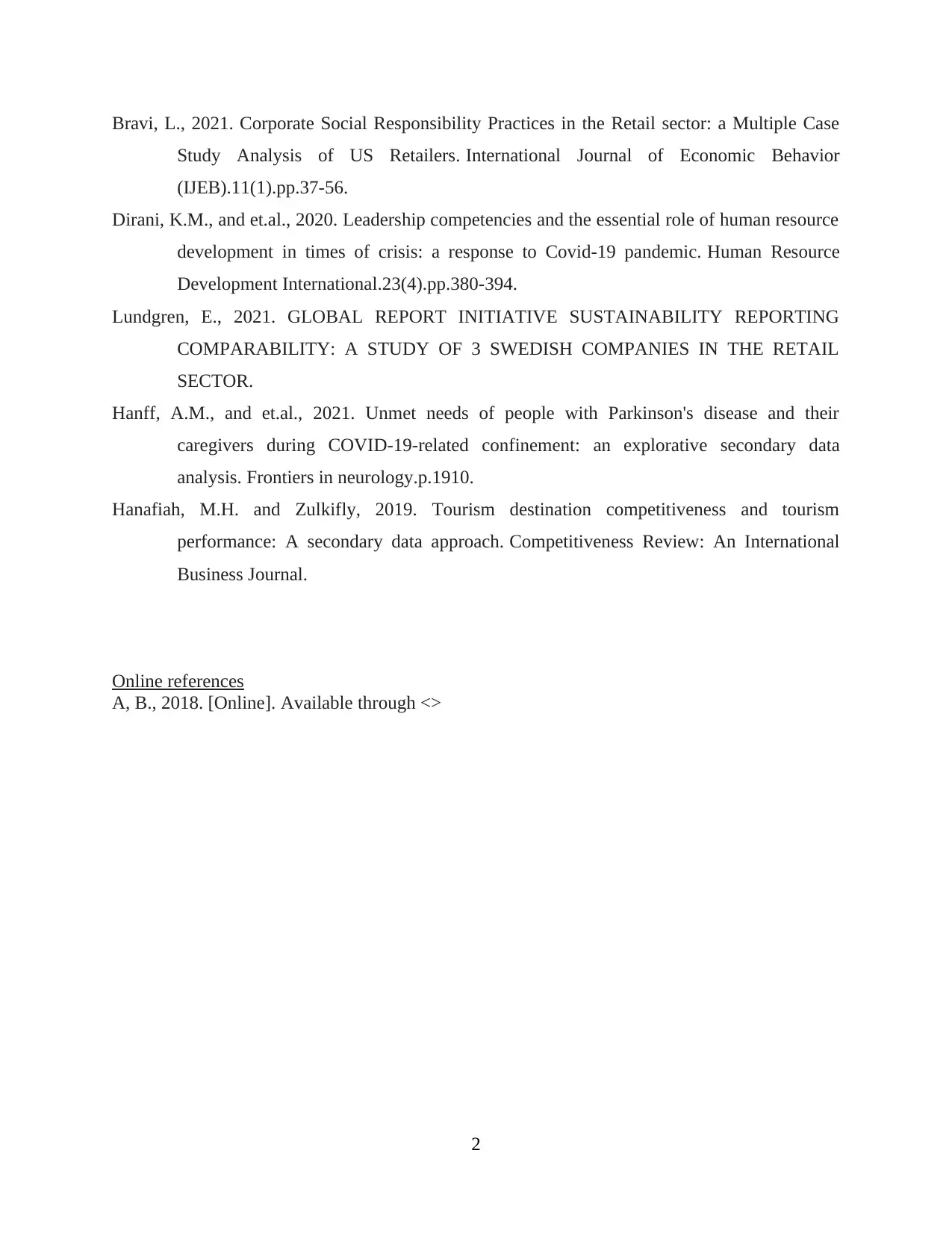
Bravi, L., 2021. Corporate Social Responsibility Practices in the Retail sector: a Multiple Case
Study Analysis of US Retailers. International Journal of Economic Behavior
(IJEB).11(1).pp.37-56.
Dirani, K.M., and et.al., 2020. Leadership competencies and the essential role of human resource
development in times of crisis: a response to Covid-19 pandemic. Human Resource
Development International.23(4).pp.380-394.
Lundgren, E., 2021. GLOBAL REPORT INITIATIVE SUSTAINABILITY REPORTING
COMPARABILITY: A STUDY OF 3 SWEDISH COMPANIES IN THE RETAIL
SECTOR.
Hanff, A.M., and et.al., 2021. Unmet needs of people with Parkinson's disease and their
caregivers during COVID-19-related confinement: an explorative secondary data
analysis. Frontiers in neurology.p.1910.
Hanafiah, M.H. and Zulkifly, 2019. Tourism destination competitiveness and tourism
performance: A secondary data approach. Competitiveness Review: An International
Business Journal.
Online references
A, B., 2018. [Online]. Available through <>
2
Study Analysis of US Retailers. International Journal of Economic Behavior
(IJEB).11(1).pp.37-56.
Dirani, K.M., and et.al., 2020. Leadership competencies and the essential role of human resource
development in times of crisis: a response to Covid-19 pandemic. Human Resource
Development International.23(4).pp.380-394.
Lundgren, E., 2021. GLOBAL REPORT INITIATIVE SUSTAINABILITY REPORTING
COMPARABILITY: A STUDY OF 3 SWEDISH COMPANIES IN THE RETAIL
SECTOR.
Hanff, A.M., and et.al., 2021. Unmet needs of people with Parkinson's disease and their
caregivers during COVID-19-related confinement: an explorative secondary data
analysis. Frontiers in neurology.p.1910.
Hanafiah, M.H. and Zulkifly, 2019. Tourism destination competitiveness and tourism
performance: A secondary data approach. Competitiveness Review: An International
Business Journal.
Online references
A, B., 2018. [Online]. Available through <>
2
1 out of 13
![[object Object]](/_next/static/media/star-bottom.7253800d.svg)





